How to use your email marketing funnel to boost sales, retention & loyalty
By Sean Tinney May 28, 2024
Email marketing is a conversion-driving machine.
In fact, email has the highest conversion rate of any B2C marketing channel (and the third-highest for B2B audiences, narrowly behind thought leadership and public speaking).
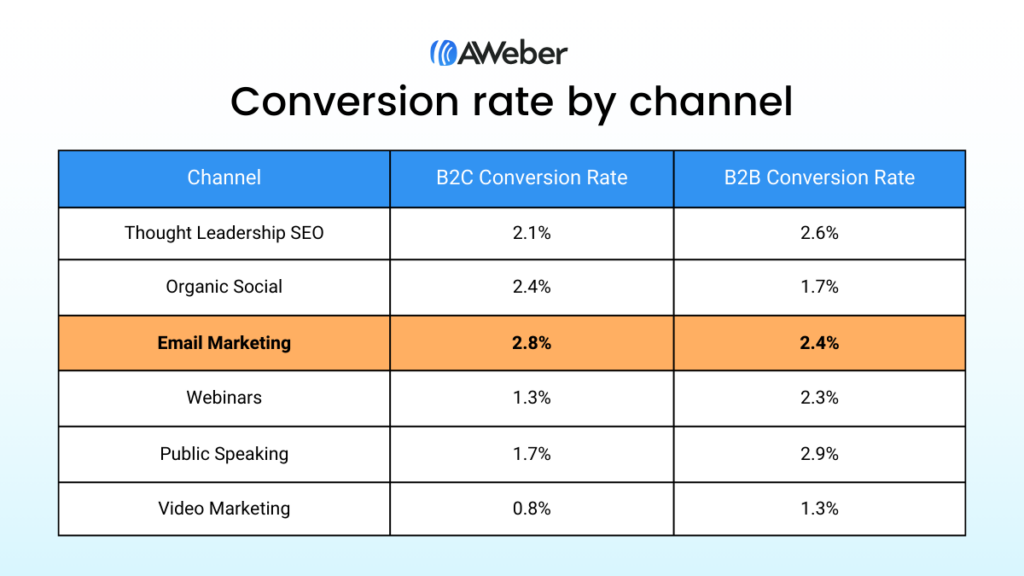
But you won’t enjoy the sales-generating benefits of email marketing unless you:
- Build a reliable pipeline of leads
- Explain your value proposition effectively
- Give new email subscribers a reason to buy
How can you do all of that?
By designing a watertight, streamlined, high-converting email marketing funnel.
What is the marketing funnel?
The marketing funnel is a tool that helps you visualize the customer journey, or the path a prospect takes as they become familiar with your company, from introduction to conversion (and hopefully beyond).
Your marketing funnel should include the following 5 stages:
1 – Awareness
2 – Consideration
3 – Conversion
4 – Loyalty
5 – Advocacy
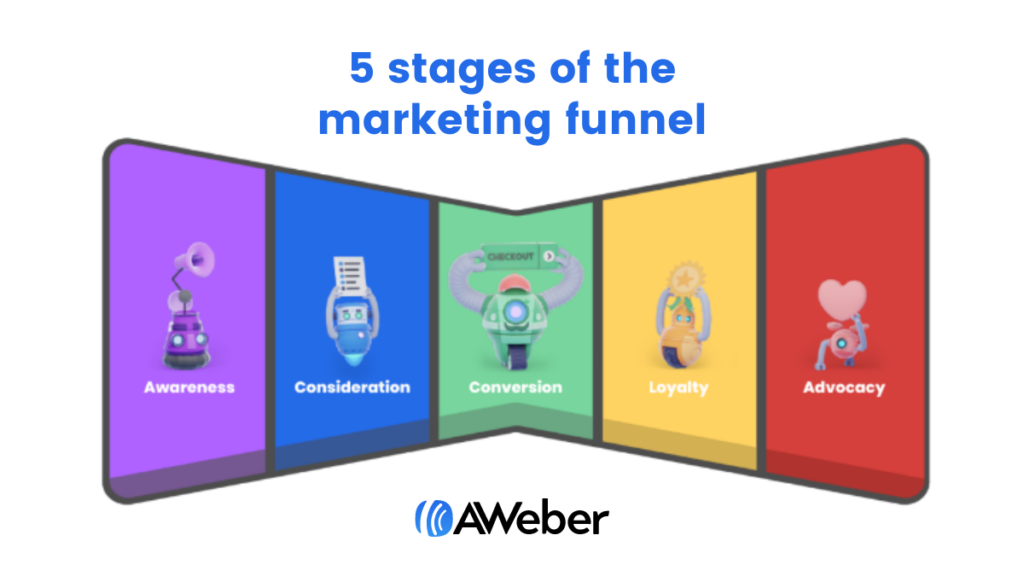
An email marketing funnel is a series of emails designed to nurture new leads and existing customers until they’re ready to place their first (or next) order.
Effective email funnels are tailored to serve the different buyer intents at each stage of the customer journey. Along the way, you’ll educate leads about your product or service, share social proof, provide them with incentives to buy, and encourage them to write a positive review or recommend you to their friends and family.
Get your email marketing funnel right and you’ll drive more sales and boost your customer lifetime value.
Email marketing funnel vs traditional marketing funnel: What’s the difference?
Email marketing funnels and traditional marketing funnels have the same goal: persuading your audience to buy from you by feeding them a steady stream of information and incentives.
However, they have different ways of achieving this goal in different ways.
The traditional marketing funnel uses a variety of marketing tools and channels — SEO, paid ads, social media, email, and more — to move customers through the different buying stages, whereas the email marketing funnel is all about promoting your products or services to people on your email list.
5 marketing funnel stages
Now that you understand what the email marketing funnel is, I’ll describe each stage and provide you real-world examples for moving your audience through those stages.
1. Awareness
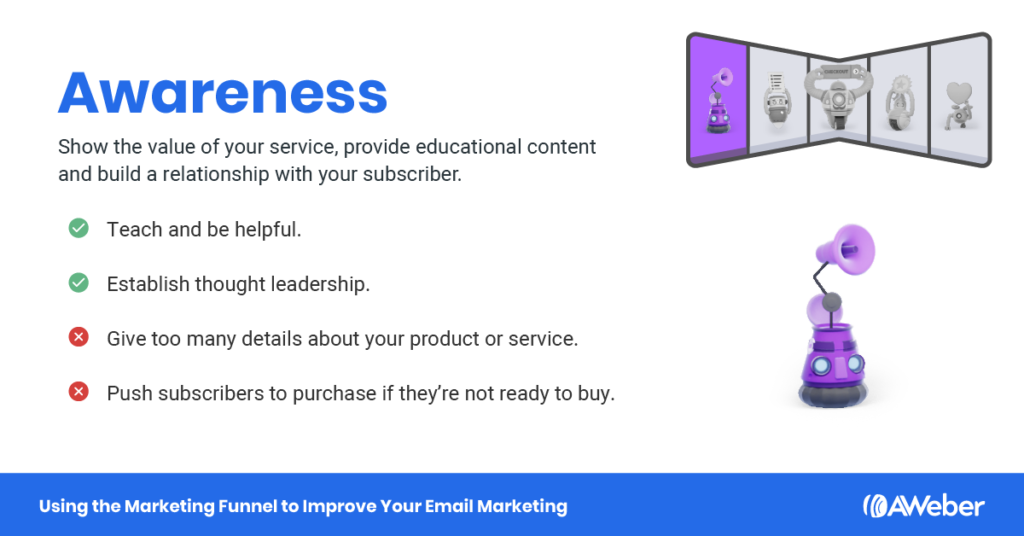
Awareness is the first of the marketing funnel stages. During this stage, prospects that are strangers to your brand and company. This is your opportunity to start building a trusted relationship with them.
It is your job during this stage of the marketing funnel to demonstrate your value to prospects through free, educational content. They’re not ready to buy from you yet — because they don’t yet understand what you bring to the table.
How to use email in the awareness stage
Not sure what free content to send in your emails? Let’s say you’re a personal trainer who’s trying to turn your prospect into paying customers and you’re using email as your main source of communication. Here are some ideas for content you could include in an automated email series to your prospects:
- Blog posts about nutrition or fitness
- A food tracking calendar worksheet
- An ebook that explains the health benefits of being fit
- A live 30-minute workout webinar
(Here are 25 brilliant lead magnet ideas to grow your email list right now.)
Here’s another example:
Fitness influencer Massy Arias builds a relationship with prospects by offering personalized guidance on training and nutrition through a quiz on her website:
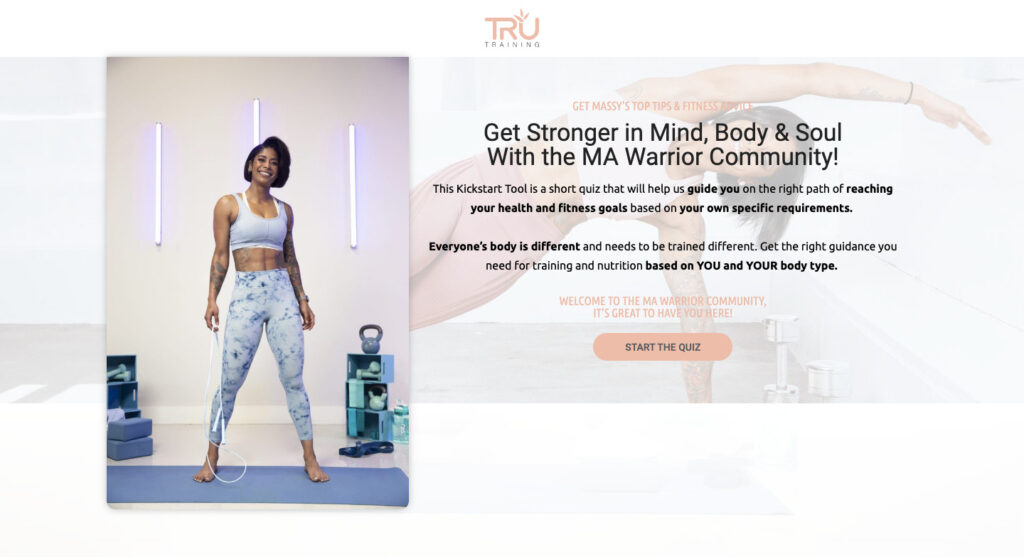
Prospects who land on Massy’s quiz landing page answer a bunch of questions about their age, body type, fitness goals, and more. Then they hand over their name and email address to receive their custom fitness plan.
With this strategy, prospects get a valuable piece of content tailored to their specific needs, while Massy gets another subscriber to her email list.
It’s a win-win!
Here’s an example:
Fitness influencer Kayla Itsines builds a relationship with her prospects by showing her expertise and demonstrating the value of her services by giving her prospects a free week of her Bikini Body Guide workout program.
When prospects sign up, they receive an ebook with a full week of workouts so they can test the program and see the value of it for themselves.

2. Consideration

Once a prospect moves past the awareness stage of the marketing funnel, they enter the consideration stage. In the consideration stage, a prospect is willing to consider purchasing your services or products. They are interested in learning more about you and what you can offer them.
Since you know more about your prospect in this marketing funnel stage than you did during the awareness stage, you can send them more targeted content that addresses their specific pain points. This helps build trust between your prospect and your brand, because you’re showing them that you understand them.
How to use email in the consideration stage
So what kind of content should you send your prospects during the consideration stage?
Let’s say you run an online store selling outdoor furniture. Potential customers might have a ton of questions about your brand and product. Is your furniture well-made? Does it look like the pictures? Is it worth the money?
It’s your job to answer those questions in your email marketing funnel by sharing content like:
- Testimonials from existing customers who love your products
- Reviews from thought leaders and trusted publications
- Quality and safety ratings from independent industry bodies
Let’s take a look at how this works in practice.
Here’s an example:
In this email, outdoor furniture brand Outer shares some of its best customer reviews:

These reviews tackle some of the common issues that might put someone off buying from Outer. More importantly, the answers come from real customers rather than the brand, which makes them way more persuasive.
Sharing reviews is especially valuable when you’re trying to convert first-time shoppers, given that 98% of consumers say they’re more likely to read reviews for a product they’ve never purchased before.
👉 Learn more: How to get Google reviews: A step-by-step guide to boosting your sales
3. Conversion
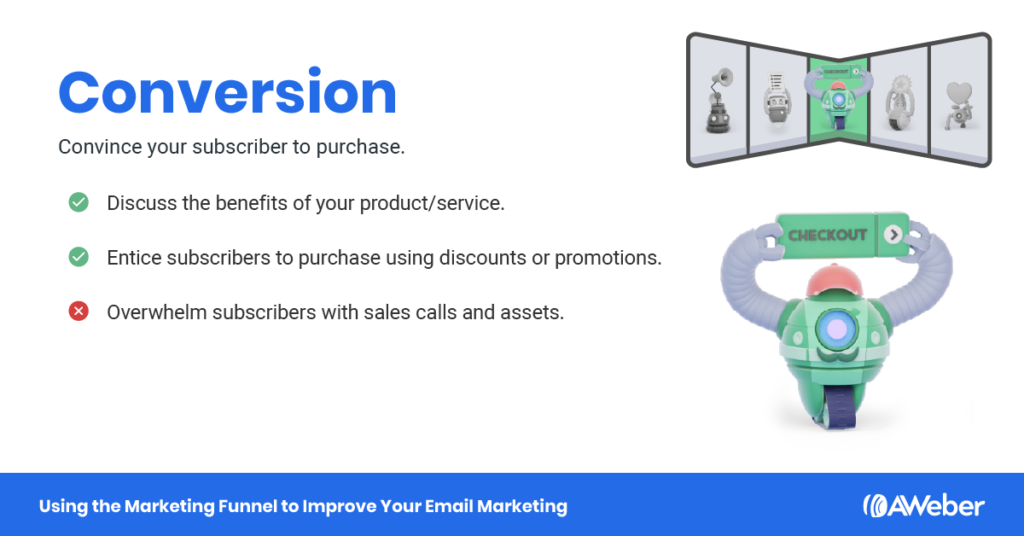
It has finally arrived: decision time. Once your prospect knows the value of your product and you have educated them on the product itself through the use of social proof, webinars, blog posts, and other educational content, they are ready to decide whether or not to purchase.
Once you’ve reached this marketing funnel stage, you can start talking about why your product and service is better than your competitors’ and why it’s perfect for your prospect. Focus on the benefits of your product/service rather than just explaining features.
How to use email in the conversion stage
Here are a few tactics you can use to convince your prospects to purchase:
- Invite prospects to a sales webinar where you show them your product/service and tell them the benefits
- Create an automated email series that describe a different benefit of your product/service
- Offer a free trial or give away samples so that prospects can see the benefits for themselves
- Send prospects an email that offers a sale or discount for purchasing within a certain timeframe
Here’s an example:
By offering discounts and deals via email, Thrive Market creates a sense of urgency around their products. If prospects are interested in purchasing but haven’t yet, this email convinces them that now is the perfect time to take action.
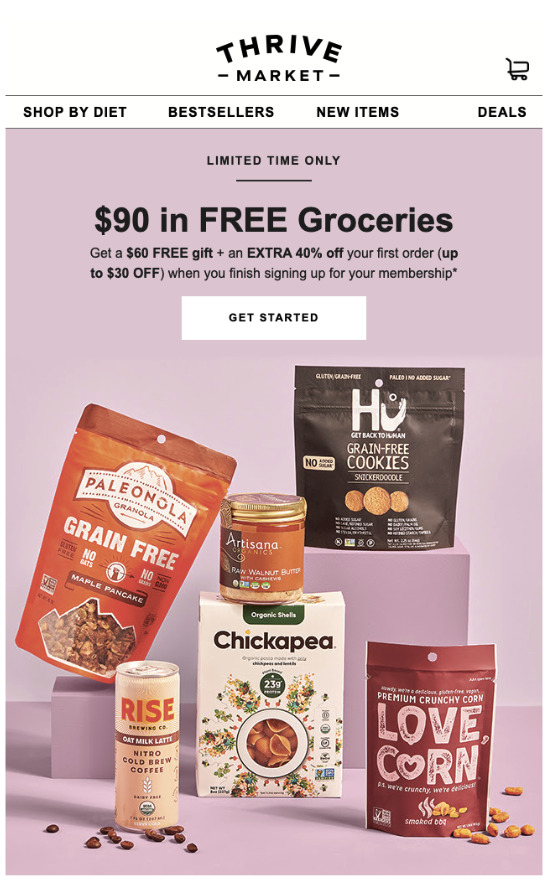
4. Loyalty

Once a prospect becomes a customer, you may be tempted to pat yourself on the back and move on to the next prospect. However, forgetting about your customers is a bad idea.
Unless you have a plan for developing customer loyalty, you’ll probably lose many of your customers, wasting a lot of your prior marketing efforts during the earlier marketing funnel stages.
Remember the Pareto Principle? Repeat customers are too valuable to ignore. So what kind of email content increases loyalty and retention?
How to use email in the loyalty stage
Let’s say you have an online coffee store. You sell subscriptions to your coffee-of-the-month club, and you don’t want your coffee-of-the-month members to lose interest and cancel their subscription. Here are a few ideas for valuable content you could include in your emails to increase retention:
- A monthly live stream to YouTube that describes the coffee-of-the-month and gives coffee brewing best practices.
- A survey that asks customers how happy they are with the coffees they are receiving and what other kinds of coffee they’d like to get.
- Educational content about the history of coffee.
- A 20 percent discount to customers that purchase a yearly subscription of your coffee-of-the-month club.
Here’s an example:
SaaS tool Zapier reaches out to users after they’ve built their first automation through the platform:

This email makes customers feel good about themselves by (metaphorically) patting them on the back for setting up their first successful automation.
More importantly, it suggests some additional automations they can create, thereby encouraging them to get more value from the platform. And the more useful they find it, the more likely they are to stay subscribed, boosting Zapier’s customer lifetime value.
👉 Learn more: Increase repeat purchases with these 5 easy tips
5. Advocacy
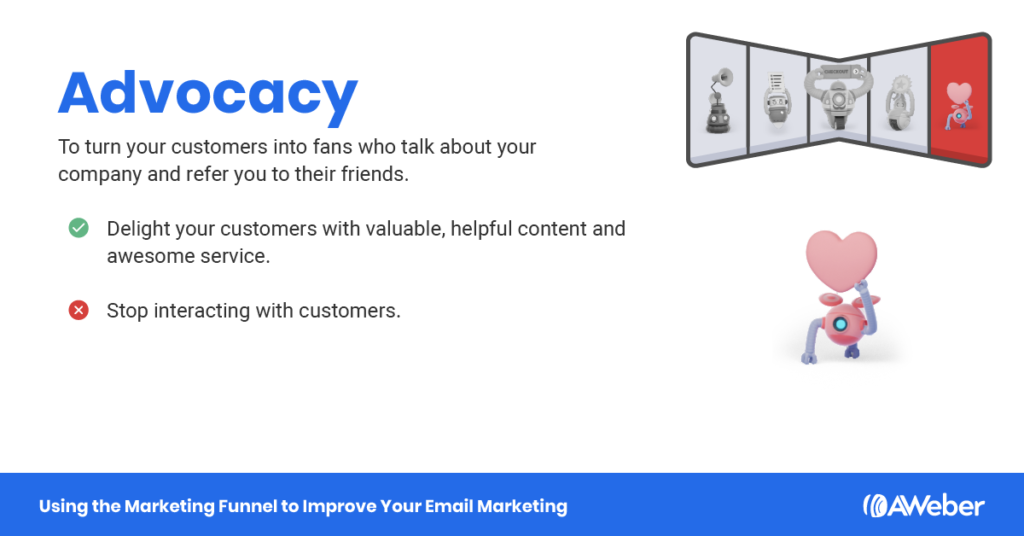
Advocacy happens when your customers become something more than customers: they become fans.
Bringing customers to this stage of the marketing funnel is extremely valuable. The most effective marketing is referral marketing. That’s when your friend tells you a certain product is awesome, you are much more likely to purchase that product because you trust your friend.
How to use email in the advocacy stage
What are some ways to use email to turn your customers into raving fans?
- Identify customers that love you and send them an email asking them to refer you to their friends
- Include a survey in an email to learn how you could improve your product or service
- Start an affiliate or loyalty program where customers get incentives for referring you
- Engage with your advocates by replying to their emails, posting on social media, offering incentives for writing reviews and participating in testimonials
You also want to collect feedback during this stage. The more you listen to your customers, the more you can learn and improve your content so it’s in line with their challenges, needs, and wants. Tools like SurveyMonkey and SurveyGizmo make collecting feedback easy.
Pro tip: Inside AWeber’s platform, you can find survey templates, too. All you have to do is add your own content into the templates and send it to your customers.
Here’s an example:
To make their customers feel special, fashion brand Torrid sends them an exclusive discount on their birthday:

Even if recipients don’t take advantage of the offer, this tactic positions Torrid as a brand that cares about its audience.
Which, in turn, makes customers more likely to recommend Torrid to their loved ones.
👉 Learn more: Birthday emails: How to boost subscriber loyalty and make more sales
5 tips to build a high-converting email marketing funnel
Now that we’ve explained the value of the email marketing funnel, let’s consider five tried-and-trusted tactics to generate more leads and sales:
1. Use your website and social channels to grow your email list
For best results, ensure your email marketing funnel is regularly topped up with new leads generated through your website and social media.
YouTube growth coach Matt Par (AKA Make Money Matt) is a master at using YouTube for lead gen. Let’s take a look at how he does it.
First up, Matt created a video explaining how to make money from YouTube without actually publishing your own content:

He clearly hit on a common pain point, because it had racked up 1.9 million views at time of writing.
The video is the first step in Matt’s marketing funnel.
He uses the YouTube description to steer viewers toward the next step — his free training offer:

Clicking that link takes you to a dedicated landing page on Matt’s website that spells out the benefits of signing up for the training.
Once you hit the CTA button…
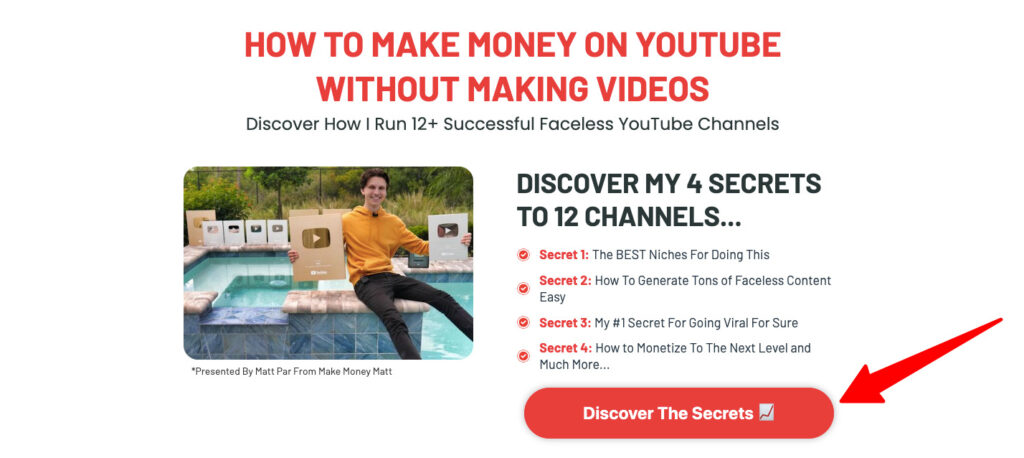
…you open up a lead capture form that prompts you to select the preferred date for your training session and hand over your email address.
Now Matt can reach out to you via email when he launches new services or special offers.
Clever stuff!
👉 Learn more: 5 Proven ways to grow your email list using YouTube
2. Send welcome emails to new subscribers
You know what they say: you only get one chance to make a good first impression.
Welcome emails are your opportunity to reassure new leads that they were right to sign up for your newsletter. Use them to share valuable information like:
- Your brand story and value proposition
- Explainer videos about your product / service
- Blog posts tackling common audience pain points
And you should consider adding some sort of promotion or incentive to drive first-time purchases, too.
Cosmetics brand Duradry has built a killer welcome sequence.
For starters, they share some background about their brand and how they created their first antiperspirant products:

Then, in the second step of their welcome sequence, they go into more depth on how their products work:

Finally, at step #3, they incorporate a bunch of customer testimonials (including video reviews for added credibility), followed by a 20% cashback incentive to encourage first-time purchases:

👉 Learn more: Welcome email campaigns: How to onboard new subscribers
3. Drive conversions with limited-time offers
Short-term discounts and promotions add an air of scarcity and urgency to your emails, which can help you turn newsletter subscribers into paying customers.
For example, online coding classes platform Codecademy shared a limited-time offer giving email subscribers 50% off their premium membership package:

That initial email was followed five days later by a final warning that the promotion was about to expire:

This combination of an attractive discount and a looming deadline gives potential customers all the incentive they need to buy now.
4. Encourage subscribers to promote your brand through reviews
Online reviews play a vital role in converting people who are at the consideration stage of the marketing funnel.
How vital?
Well, 98% of shoppers say reviews are an essential resource when making purchase decisions, while 45% won’t purchase a product with no available reviews.
So it pays to build a constant stream of reviews. Make it happen by asking people who’ve recently bought a product or service to review their purchase. Then share the results as part of your email marketing funnel, just like dog food brand Sundays did here:

5. Ask customers to refer friends and family
Reviews aren’t the only way your customers can help you drive conversions.
They can play an even more direct role in the path to purchase by encouraging friends, family, colleagues, and random people they meet in the street to buy your products or services.
How can you turn existing customers into brand advocates? By building a referral program and sharing it with your email subscribers, just like digital marketing agency Circles did here:

This tactic is particularly effective given that referrals help you reach more valuable customers.
Indeed, an analysis of almost 10,000 new German bank accounts over a 33-month period found that referred customers:
- Are more loyal
- Generate higher profit margins
- Show a higher customer lifetime value
Create your own email marketing funnel
Develop your email strategy with the marketing funnel in mind. Doing so, you’ll convert more prospects into customers and more customers into fans, which means more money for your business. Yay!
And with a tool like email automation, it’s easier than ever before to move people through your funnel toward advocacy.
Automation features allow you to give each prospect the content, information, or products they need when they need it most. It personalizes their experience at all areas of the funnel.
And once it’s set up, you never have to lift a finger! You’ve effectively set up an engine that generates passive income to fuel your passion.
Start implementing your email marketing funnel in your AWeber account. Don’t have an account yet. No problem, signing up is quick and easy.
 87% off ends soon!
87% off ends soon! 
